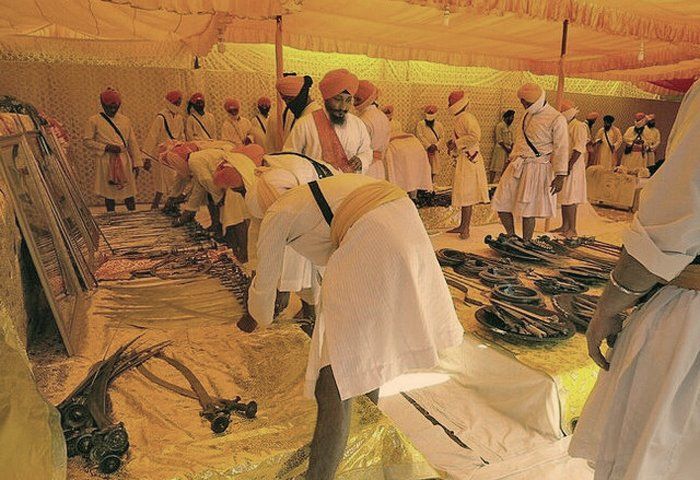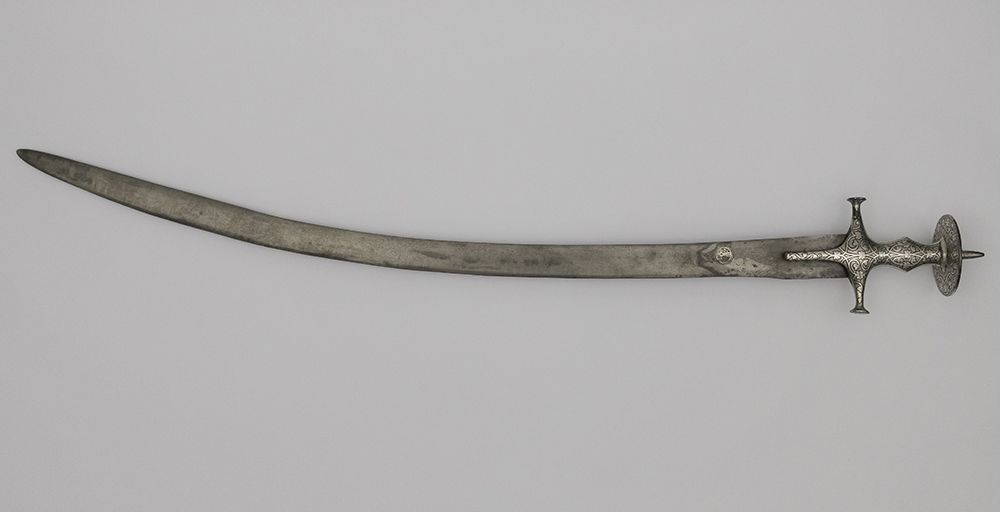1st Dohara: "Saang Sarohi…”

This steek is being written through the translation of existing steeks, existing Kosh, kathas, and other historical references. This list is not complete: Dasam Sri Guru Granth Sahib Ji Shromani Steek by Giani Isher Singh Ji Ramgarhia (Ropar) as published by Sant Teja Singh Ji Nihang Singh (Gurdwara Rajdhani Bunga Nihang Singha, Mehron) Vidyarthi of Sant Giani Gurbachan Singh Khalsa Ji Bhindranwale, Guru Shabad Ratnaakar Mahaan Kosh by Bhai Kahn Singh Ji Nabha, Katha by Giani Harbhajan Singh Dhudike, Katha by Giani Sher Singh Ji Ambale Wale (Budha Dal), Katha by Bhai Sukha Singh Ji UK wale, Sri Dasam Granth Sahib Ji Steek by Pandit Narain Singh Lahore Wale, Sri Dasam Granth Sahib Ji Steek by Giani Bishan Singh (Khalsa College Amritsar), Sri Dasam Granth Teeka by Dr. Rattan Singh Jaggi, ancient Indian texts such as Dhanurveda, Mahabharata, among the like.
All of the steeks mentioned can be found on www.gurmatveechar.com
–
Dhan Dhan Kalgidhar Maharaj, Chittey Baja Wale Paatshah, Neela-Ghorh Asvaar, Sarbans Daani, Dasmesh Pita Ji Sri Guru Gobind Singh Sahib Ji Maharaj –
ਦੋਹਰਾ (Doharaa)
ਸਾਂਗ ਸਰੋਹੀ ਸੈਫ ਅਸ ਤੀਰ ਤੁਪਕ ਤਰਵਾਰ ॥
Saa[n]g Sarohee Saif As Theer Thupak Tharvaar
ਸਤ੍ਰਾਂਤਕ ਕਵਚਾਂਤਿ ਕਰ ਕਰੀਐ ਰੱਛ ਹਮਾਰ ॥੧॥
Sathraa[n]thak Kavachaa[n]th[i] Kar Kareeai Rachh Hamaar
–
The attempt is to provide an in-depth explanation of the Shastar in question and provide an image that allows one to understand that specific Shastar. This steek will start off with examples of many South Asian Shastars but with repetitions of the Shastar names, there will be other examples from all over the world.

From these various explanations, we can understand that a Saang is a type of metal lance. Giani Sher Singh Ji give an example of Mata Bhaago Ji using a Saang in battle. We can find this in Gurpratap Suraj Prakash:
ਇਕ ਮਾਈ ਭਾਗੋ ਹੁਤੀ, ਚਾਲੀ ਸਿੰਘ ਮਝਾਰ।
Eik Maaee Bhaago Huthee Chaalee Singh Majhaar
There is one Mai Bhago amidst the 40 Singhs
ਤੁਰਕ ਹਤਯੋ ਖਰ ਸਾਂਗ ਤੇ, ਗੇਰਯੋ ਧਰਾ ਮਝਾਰ ॥੧॥
Thurk Hathyo Khar Saa[n]g Thae Gaeyo Dhharaa Majhaar
She killed a Mughal with a sharp Saang, dropping him on the ground
(Adhiyaye 11, Ayan 1).
The Saang is so heavy that even without swinging it, the weight of it will pierce through anyone that meets its tip. It tears up armour and horses in battle.

Rajasthan is known for producing many kinds of swords and you can still find many authentic armouries today. It is hard to define a Sirohi because some may define the sword based on the region itself whereas others may simply refer to the technique in which it was made or the design of the blade.
Maharaj puts the Saif & Sirohi together multiple times in Shastar Naam Maalaa. It is as if Maharaj is telling us that all swords from both the west and east belong to Akaal Purakh. Vaheguru Ji's Shakti is not selective and just within South Asia. All of the weaponry of the world is Maharaj's Shakti.
Giani Sher Singh explain to us that the origins of the word As[i] comes from the Sanskrit "Asee Dhaathoo"; meaning a shastar that cuts. Us/As[i] & Talwar are general names for swords. There are many specific kinds of swords that fall underneath the label of As[i]/Us or Talwaar.

The term "Thupak" refers to a firearm. The cannon evolved into muzzleloading portable firearms such as the matchlock, the wheel lock, flintlock, percussion caps. Muzzleloading means you would stuff the ammunition into the barrel of the firearm. The ways of igniting the ammunition changed. Matchlock requires lighting a wick with a flame (like a cannon), wheel lock and flintlock requires friction and a piece of metal/stone that would ignite the ammunition, percussion caps require a small explosive cap that would be carried around to ignite the ammunition. Most modern firearms use cartridges which include ammunition, gunpowder, and the primer that propels the bullet (Source: RCMP Firearms Safety Guide). Thupak is also inclusive of modern firearms such as shotguns, handguns, assault rifles, etc.
Here we see As[i] & Talwaar appear in the same pangkti despite being synonymous with each other. There is a lot of repetition of Names in Shastar Naam Maalaa. Giani Sher Singh Ji explain that this Bani is just as if we were repeating "Vaheguru, Vaheguru...". The more we repeat these names with love, they become engrained in us and become our bhagti.
Maharaj's Saroop is Nirvair (without enmity) so what is an enemy for a Sikh? In Gaathaa by Sri Guru Arjan Dev Sahib Ji, Maharaj refer to the five vikaars as the five enemies:
ਹਤੰ. ਪੰਚ ਸਤ੍ਰਣ ਨਾਨਕ; ਹਰਿ ਬਾਣੇ ਪ੍ਰਹਾਰਣਹ ॥੬॥
Hath[ng] Pa[n]ch SathraN Naanaak Har[i] BaaNae PrahaaraNah
Killing the five enemies by attacking them with the Arrow of Vaheguru.
Developing Samdrishti (ability to see equally everyone as Vaheguru), both enemies and friends are seen as One. Just as Sri Guru Arjan Dev Sahib Ji teach us in Raag Aasaa:
ਮਿਤ੍ਰ ਸਤ੍ਰੁ ਜਾ ਕੈ ਏਕ ਸਮਾਨੈ ॥ ਪ੍ਰਭ ਅਪੁਨੇ ਬਿਨੁ ਅਵਰੁ ਨ ਜਾਨੈ ॥੨॥
Mithr Sathr[u] Ja Kai Aek Samaanai; Prabh Apunae Bin[u] Avar[u] n Jaanai
Knowing both friend and enemy as One, [you] do not accept anyone else's existence besides that of Vaheguru's.
As we touched on briefly in the last section: Khalsa exists to serve those in need and protect the defenseless (Degh-Tegh Fateh). Dhan Guru Nanak Dev Sahib Ji stood up to Babbar when he was terrorizing South Asia. Dhan Guru Amar Das Sahib Ji made Akbar eat langar equally with the common people. Dhan Guru Arjan Dev Ji gave Shaheedi for maintaining the sanctity of Gurbani. Dhan Guru Hargobind Sahib Ji and Dhan Guru Gobind Singh Sahib Ji fought battles of Dharam Yudh (maintaining righteousness). Zafarnama is often quoted for this couplet (Maharaj's Letter to Aurangzeb):
ਚੁ ਕਾਰ ਅਜ਼ ਹਮਹ ਹੀਲਤੇ ਦਰ ਗੁਜ਼ਸ਼ਤ॥
Chu Kaar Az Hamah Heelathae Dhar Guzashth
When all the strategies have been exhausted,
ਹਲਾਲ ਅਸਤ ਬੁਰਦਨ ਬ ਸ਼ਮਸ਼ੀਰ ਦਸਤ॥
Halaal Asth Burdhan B Shamsheer Dasath
It is righteous to take a sword in your hand.
(adapted translation from multiple different translations)
Those who terrorize the innocent are political enemies. There are many political strategies to help out those who are weak even before picking up the sword, they will be spoken about later in this steek.
Kavach refers to armour. Maharaj has combined the word with -aanth[i] referring to the end of something. There is Gurbani with "Kavach" in the title which emphasizes seeking Maharaj's protection and having shakti on our side. These include Ram Kavach, Brahm Kavach, Durga Kavach, and Sarbloh Kavach. You can learn more about them in Brahm Kavach & Bhagauti Asthothr Steek by Giani Gurwinder Singh Ji.
Dhan Dhan Sri Guru Gobind Singh Sahib Ji complete Sri Charitropakhyan with Benti Chaupai Sahib and they begin with:
ਹਮਰੀ ਕਰੋ; ਹਾਥ ਦੈ ਰੱਛਾ ॥
Hamree Karo Haathh Dhai Rachhaa
Please protect me with Your Own Hand
Maharaj, please protect us from vikaars, our own ego, and the overall illusion of Maya. Maharaj, let your shakti be on our side in maintaining Dharam.
–
Please correct all mistakes made as soon as you see them Ji. We all contribute to make this the best steek for the benefit of the Sangat. Please send pictures and videos of shastars for this steek. This Steek is being offered in the laps of the Khalsa Panth. Again please forgive me for all my mistakes Ji.
~ Aaeenaa

